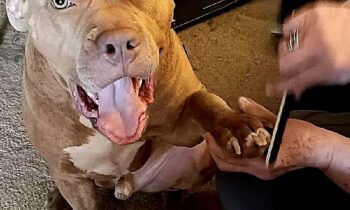
Canine cognitive dysfunction, otherwise known as doggy dementia. Last week, I outlined what it is and how it’s diagnosed. This week, I’m calling on an expert to help answer a very important question: what can you do when you think your dog may have it?
Eileen Anderson writes about learning theory, about her life with three dogs, and about training with positive reinforcement in her popular blog, Eileen and Dogs, and for other publications. Eileen has written a book on canine cognitive dysfunction. Here’s the information from Amazon on the publication:
Remember Me? is a guidebook for owners of dogs who are losing their mental faculties as they age, and the story of a dog and owner who retained their bond through this most difficult situation.
If you have an aging dog, Remember Me? will give you the information you need to weather the difficult condition and give your dog the most fulfilling life possible. In Remember Me, you will learn:
- About the symptoms of canine cognitive dysfunction, medications and other interventions that are showing promise in treating the condition
- How to adapt your home and habits to keep your dog safe
- The many products available to solve the problems of senior dogs
- How to make things easier on yourself, physically and emotionally
- The complex question of euthanasia and how to make your own decision about it
The story of author Eileen Anderson’s small terrier Cricket, who developed dementia, is threaded through the book. As Cricket’s dementia worsened she paced, she circled, she stood in corners, she forgot what she was doing, and at times she lost and found her owner repeatedly. For the last weeks of her life she even forgot how to drink water. As Cricket’s condition deteriorated and needs changed, Anderson learned about the disease and developed methods to care for her dog.
She shares these methods in Remember Me? and her calm, conversational tone is soothing to dog owners who are suffering–sometimes more than their dogs.
https://www.amazon.com/Remember-Me-Loving-Cognitive-Dysfunction/dp/1943634017

Photo by Megan Cuillia
Here’s one of my favorite quotations from Eileen Anderson’s book:
[A]s your dog’s cognitive decline progresses, even the most familiar behaviors and routines can be forgotten. Perhaps this is what gives rise to some of the anxiety that can come with dementia.
Imagine if you moved to another town, changed jobs, got divorced, and then remarried, all in a short time. You’re living with someone new, whom you adore but whose habits you haven’t yet learned, and let’s throw in a couple teenage stepkids for good measure. You don’t have a regular grocery store to go to. You have a new boss and coworkers. You can’t even go to your favorite restaurant; it’s in another town.
For most people, that would be very stressful. Now imagine if every day were like that, for the rest of your life. This is what dementia is like for a lot of people, and probably for dogs in their way. As they forget things, they become unmoored in life, and they can’t learn new habits or routines to replace the old.
I asked Eileen if she could give advice to a dog owner who suspects their dog might have canine cognitive dysfunction. What’s the first step in diagnosis and treatment?
Val Hughes: Many people check online first to diagnose their own health issues, and that seems to be true when they diagnose their pets’ health issues as well. What advice would you give to a dog owner who has read online about CCD, who suspects their dog may have that condition, and who is taking the dog to their veterinarian for a professional opinion? How can the dog owner best assure that their concerns are taken seriously?
Eileen Anderson: I love how you worded that question! That is very practical!
The way CCD is diagnosed is called a “diagnosis of exclusion.” That means there isn’t a certain test to determine that condition. Instead, the vet has to rule out all other likely conditions. If other tests are negative and the symptoms fit, the vet will then determine that the dog probably has CCD.
Every symptom of CCD is also a symptom of other medical conditions, and some of them are severe and life-threatening. A dog with some of the symptoms could have a brain tumor, tick fever, or even a severe liver problem. So all these symptoms need to be taken seriously.
My advice is to print and fill out a list of symptoms to take to the vet. I provide such a list on my website at http://dogdementia.com/wp-content/uploads/2015/04/Canine-Cognitive-Dysfunction-Checklist.pdf. Remember, your vet probably won’t see all the symptoms when your dog is in the office. So you need to be a careful observer and help the vet get the whole picture.
Be ready to tell your vet how long the various symptoms have been going on. A vet who is familiar with CCD will likely order some tests to rule out other conditions.
If the vet says that your dog is just showing signs of normal aging, she could be correct or she could be unfamiliar with CCD. You know your dog. If your dog is showing some of these symptoms and your vet isn’t concerned, ask if she would be willing to consult with a veterinary behaviorist. Vet behaviorists are specialists who are familiar with CCD and all its treatments. If she is not willing, consider going to another vet for a second opinion.
Remember: you are the person in the best position to tell if something is wrong with your dog. But it takes a veterinarian to determine what the problem is.
Next week, more questions about canine cognitive dysfunction, with answers from Eileen Anderson, whose book on the subject, Remember Me?, just won a Maxwell Award for excellence from the Dog Writers Association of America. It was chosen as best book in 2016 in the category of Behavior, Health or General Care.



